The AMD Zen and Ryzen 7 Review: A Deep Dive on 1800X, 1700X and 1700
by Ian Cutress on March 2, 2017 9:00 AM ESTBenchmarking Performance: CPU Rendering Tests
Rendering tests are a long-time favorite of reviewers and benchmarkers, as the code used by rendering packages is usually highly optimized to squeeze every little bit of performance out. Sometimes rendering programs end up being heavily memory dependent as well - when you have that many threads flying about with a ton of data, having low latency memory can be key to everything. Here we take a few of the usual rendering packages under Windows 10, as well as a few new interesting benchmarks.
Corona 1.3
Corona is a standalone package designed to assist software like 3ds Max and Maya with photorealism via ray tracing. It's simple - shoot rays, get pixels. OK, it's more complicated than that, but the benchmark renders a fixed scene six times and offers results in terms of time and rays per second. The official benchmark tables list user submitted results in terms of time, however I feel rays per second is a better metric (in general, scores where higher is better seem to be easier to explain anyway). Corona likes to pile on the threads, so the results end up being very staggered based on thread count.
Blender 2.78
For a render that has been around for what seems like ages, Blender is still a highly popular tool. We managed to wrap up a standard workload into the February 5 nightly build of Blender and measure the time it takes to render the first frame of the scene. Being one of the bigger open source tools out there, it means both AMD and Intel work actively to help improve the codebase, for better or for worse on their own/each other's microarchitecture.
LuxMark
As a synthetic, LuxMark might come across as somewhat arbitrary as a renderer, given that it's mainly used to test GPUs, but it does offer both an OpenCL and a standard C++ mode. In this instance, aside from seeing the comparison in each coding mode for cores and IPC, we also get to see the difference in performance moving from a C++ based code-stack to an OpenCL one with a CPU as the main host.
POV-Ray 3.7
Another regular benchmark in most suites, POV-Ray is another ray-tracer but has been around for many years. It just so happens that during the run up to AMD's Ryzen launch, the code base started to get active again with developers making changes to the code and pushing out updates. Our version and benchmarking started just before that was happening, but given time we will see where the POV-Ray code ends up and adjust in due course.
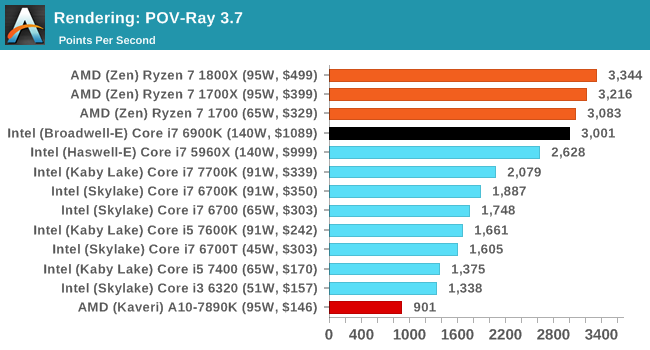
Cinebench R15
The latest version of CineBench has also become one of those 'used everywhere' benchmarks, particularly as an indicator of single thread performance. High IPC and high frequency gives performance in ST, whereas having good scaling and many cores is where the MT test wins out.
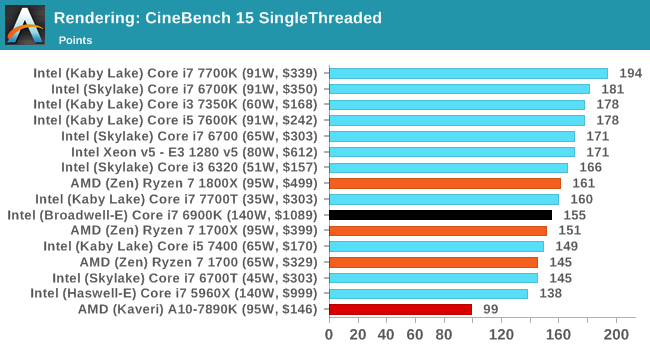
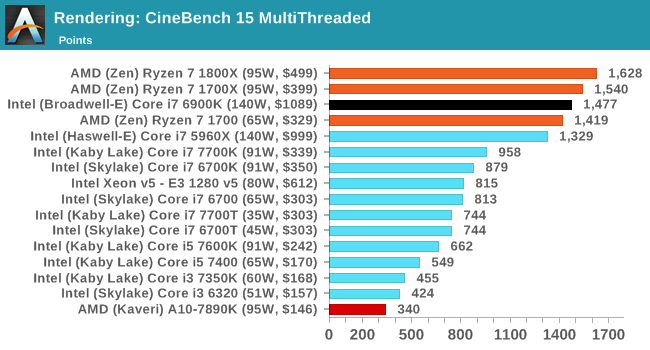


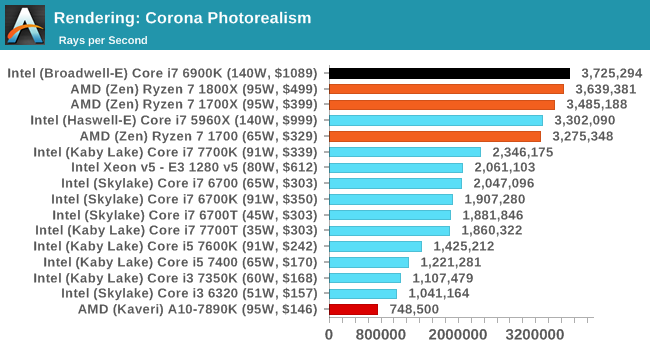
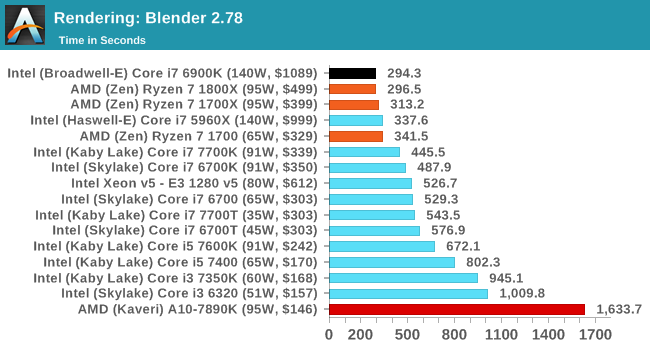

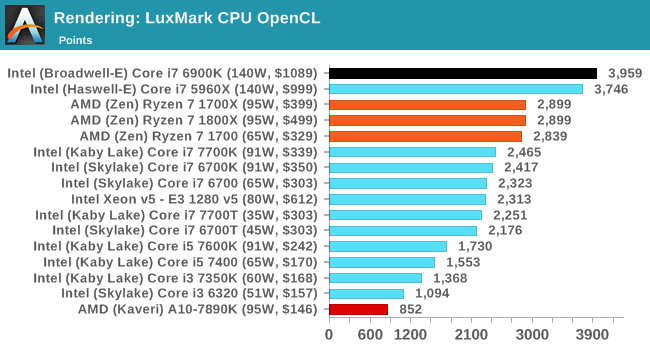








574 Comments
View All Comments
mapesdhs - Sunday, March 5, 2017 - link
If you have a Q6600, I can understand that, but the QX9650 ain't too bad. ;)Marburg U - Monday, March 6, 2017 - link
I'm on a Q9550 running at 3.8 for the past 6 years. I could still run modern games at 1050p, with a r9 270x, but that's the best i can squeeze out of it. Mind that i'm still on DDR2 (my motherboard turns 10 in a few months). I really want to embrace a ultra wide monitor.mapesdhs - Monday, March 6, 2017 - link
Moving up to 2560x1440 may indeed benefit from faster RAM, but it probably depends on the game. Likewise, CPU dependencies vary, and they can lessen at higher resolutions, though this isn't always the case. Still, good point about DDR2 there. To what kind of GPU were you thinking of upgrading? Highend like 1080 Ti? Mid-range? Used GTX 980s are a good deal these days, and a bunch of used 980 Tis will likely hit the market shortly. I've tested 980 SLI with older platforms, actually not too bad, though I've not done tests with my QX9650 yet, started off at the low end to get through the pain. :D (P4/3.4 on an ASUS Striker II Extreme, it's almost embarassing)Ian.
Meditari - Monday, March 6, 2017 - link
I'm actually using a Q9550 that's running at 3.8 as well. I have a 980ti and it can do 4k, albeit at 25-30fps in newer games like Witcher 3. Fairly certain a 1080ti would work great with a Q9550, but I feel like the time for these chips is coming to an end. Still incredible that a 8 year old chip can still hold it's own by just upgrading the GPUmapesdhs - Tuesday, March 7, 2017 - link
Intriguing! Many people don't even try to use such a card on an older mbd, they just assume from sites reviews that it's not worth doing. Can you run 3DMark11/13? What results do you get? You won't be able to cite the URLs here directly, but you can mention the submission numbers and I can compare them to my 980 Ti running on newer CPUs (the first tests I do with every GPU I obtain are with a 5GHz 2700K, at which speed it has the same multithreaded performance as a stock 6700K).What do you get for CB 11.5 and CB R15 single/multi?
What mbd are you using? I ask because some later S775 mbds did use DDR3, albeit not at quite the speeds possible with Z68, etc. In other words, you could move the parts on a better mbd as an intermediate step, though finding such a board could be difficult. Hmm, given the value often placed on such boards, it'd probably be easier to pick up a used 3930K and a board to go with it, that would be fairly low cost.
Or of course just splash for a 1700X. 8)
Ian.
Notmyusualid - Tuesday, March 7, 2017 - link
Welcome to the 21:9 fan club brother.But be careful of the 1920x1080 screens, my brother's 21:9 doesn't look half as good as my 3440x1440 screen.. It just needs that little bit more verticle resoultion.
My pals 4k screen is lovely, and brings his 4GB 980 GTX to its knees. Worse aspect ratio (in my opinion), and too many pixels (for now) to draw.
Careful of second-hand purchases too, many panels with backlight-bleed issues out there, and they are returns for that reason, again, in my opinion.
AnnonymousCoward - Monday, March 6, 2017 - link
Long story short:20% lower single-thread than Intel
70% higher multi-thread due to 8 cores
$330-$500
Mugur - Tuesday, March 7, 2017 - link
Actually, on average -6.8% IPC versus Kaby Lake (at the same frequency) - I believe this came directly from AMD. Add to this a lower grade 14nm process (GF again) that is biting AMD again and again (see last year RX480). Motherboard issues (memory, HPET), OS/application issues (SMT, lack of optimizations).All in all, I'm really impressed of what they achieved with such obstacles.
AnnonymousCoward - Tuesday, March 7, 2017 - link
Just looking at CineBench at a given TDP and price, AMD is 20% lower. That's the high level answer, regardless of IPC * clock frequency. I agree it's a huge win for AMD, and for users who need multicore performance.Cooe - Monday, March 1, 2021 - link
Maybe compare to Intel's Broadwell-E chips with actually similar core counts.... -_-